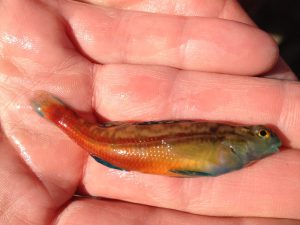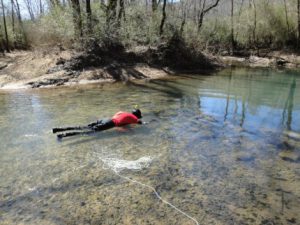
Michael holding a male darter. The bright color patterns differ for each of the over 200 species. Photo by Tamra Mendelson.
The activities are as follows:
- Teacher Guide
- Student activity, Graph Type A, Level 3
- Student activity, Graph Type B, Level 3
- Student activity, Graph Type C, Level 3
- Grading Rubric
- Digital Data Nugget on DataClassroom
What is a species? The biological species concept says species are groups of organisms that can mate with each other but do not reproduce with members of other similar groups. How then do animals know who to choose as a mate and who is a member of their own species? Communication plays an important role. Animals collect information about each other and the rest of the world using multiple senses, including sight, sound, sonar, and smell. These signals may be used to figure out who would make a good mate and who is a member of the same species.

Michael snorkeling, looking for darters.
Michael is a scientist interested in studying how individuals communicate within and across the boundaries of species. He studies darters, a group of over 200 small fish species that live on the bottom of streams, rivers, and lakes. Michael first chose to study darters because he was fascinated by the bright color patterns the males have on their bellies during the breeding season. Female darters get to select which males to mate with and the males fight with each other for access to the females during the mating season. Species identification is very important during this time. Females want to make sure they choose a member of their own species to mate with. Males want to make sure they only spend energy fighting off males of their own species who are competing for the same females. What information do females and males use to guide their behavior and how do they know which individuals are from their own species?
Across all darter species, there is a huge diversity of color patterns. Because only males are brightly colored and there is such a diversity of colors and patterns, Michael wondered if males use the color patterns to communicate species identity during mating. Some darter species have color patterns that are very similar to those of other darter species. Perhaps, Michael thought, the boundaries of species are not as clear as described by the biological species concept. Some darter species may be able to hybridize, or mate with members of a different species if their color patterns are very close. Thus, before collecting any data, Michael predicted that the more similar the color patterns between two males, the more likely they would be to hybridize and act aggressively towards each other. If this is the case, it would serve as evidence that color pattern may indeed serve as a signal to communicate darter species identity.

Michael (right) in the field, collecting darters. Photo by Tamra Mendelson.
Michael collected eight pairs of darter species (16 species in all) from Alabama, Mississippi, Tennessee, Kentucky, South Carolina, and North Carolina and brought them all back to the lab. In some species pairs the color patterns were very similar, and in some they were very different. For each species pair, he put five males of both species and five females of both species in the same fish tank and observed their behavior for five hours. He did this eight times, once for each species pair (for a total of 1,280 fish!). During the five-hour observation period, he recorded (1) how many times females mated with males of their own species or of a different species and (2) how many times males were aggressive towards males of their own species or of a different species. He used these data to calculate an index of bias for each behavior, to show whether individuals had stronger reactions towards members of their own species.
Featured scientist: Michael Martin from the University of Maryland, Baltimore County
Flesch–Kincaid Reading Grade Level = 10.9
Videos showing darter behavior:
Darter species used in the experiment:


Do you have an answer key or guide for the correct answers?
Yes, you can request teacher guides here: https://datanuggets.org/requesting-teacher-guides/